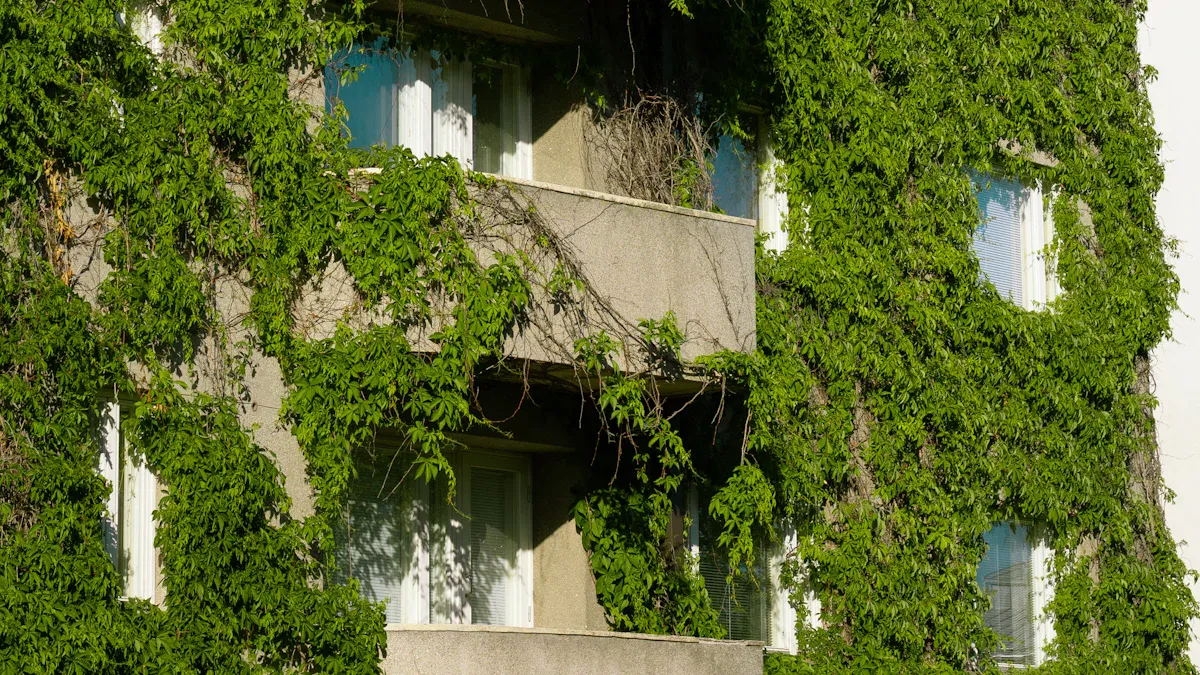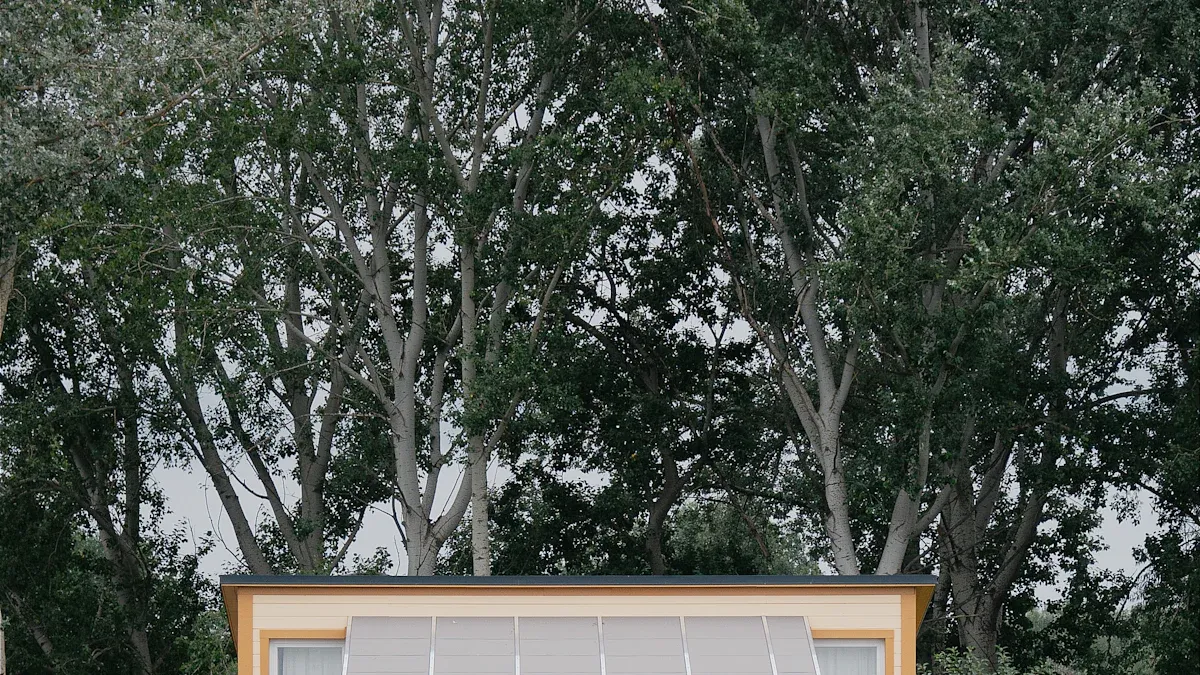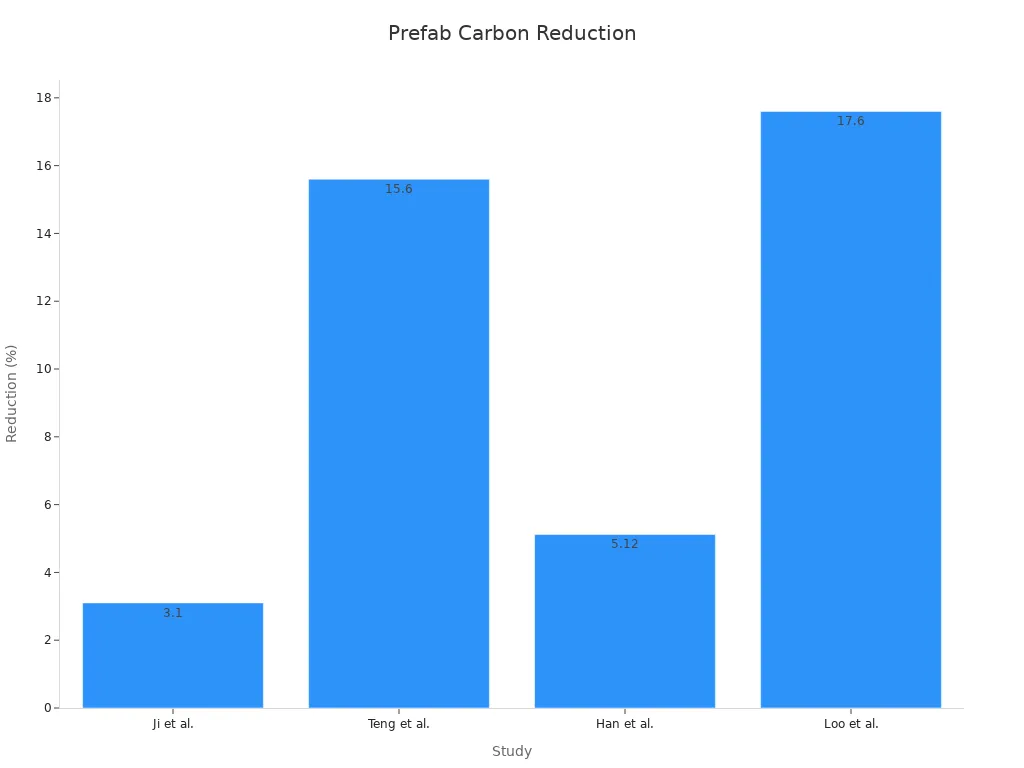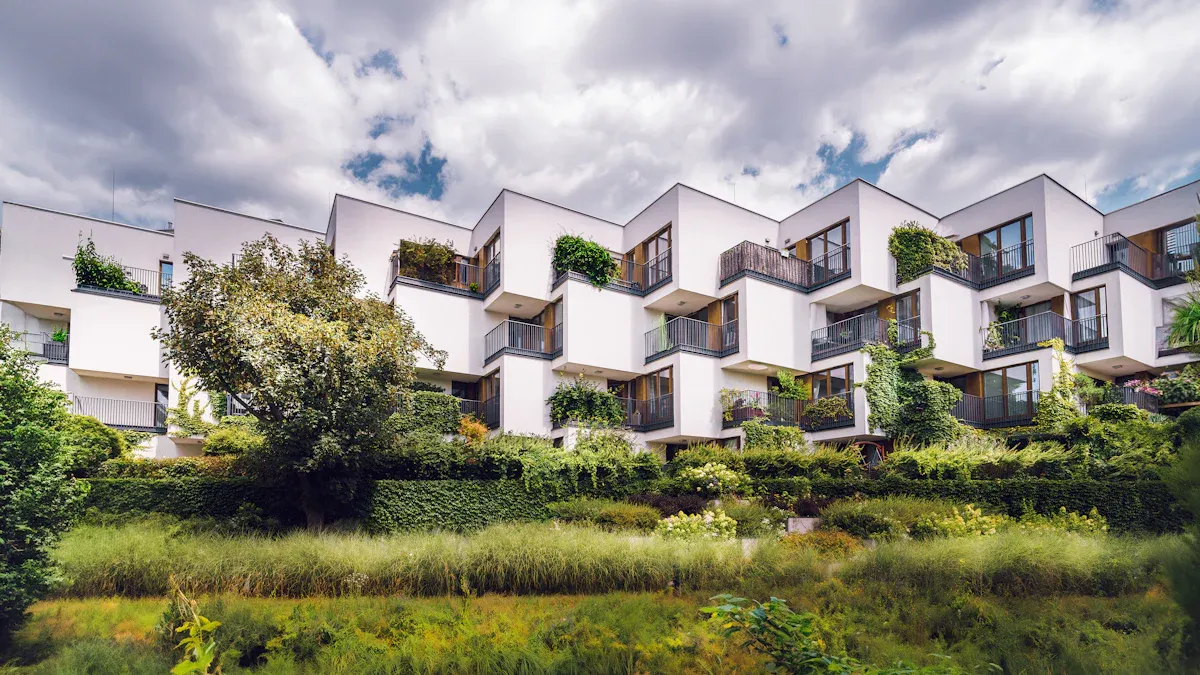
Eco-friendly prefab houses offer a sustainable and innovative solution to meet modern housing demands. These prefab houses significantly reduce greenhouse gas emissions by up to 8.06% compared to traditional construction methods. Equipped with advanced energy-efficient systems, including PV solar panels, they minimize carbon emissions and decrease energy consumption by 87.6 kWh/m². As the need for affordable prefab housing continues to rise, these eco-friendly prefab houses tackle urbanization challenges with creative designs such as the space capsule house, providing compact and sustainable living spaces.
Environmental Benefits of Eco-Friendly Prefab Houses

Energy Efficiency and Reduced Carbon Footprint
Eco-friendly prefab houses excel in energy efficiency, significantly reducing their carbon footprint. These homes often incorporate advanced insulation, energy-efficient HVAC systems, and LED lighting, which collectively lower operational carbon emissions. Additionally, integrating renewable energy sources, such as solar panels or wind turbines, further decreases reliance on fossil fuels.
A comparative analysis of modular and conventional construction methods highlights the environmental advantages of prefab houses. The table below summarizes findings from various studies:
| Study | Findings | Carbon Emission Reduction | Methodology |
|---|---|---|---|
| Ji et al. | 3.1% carbon reduction through prefabrication | 3.1% | Comparative analysis |
| Teng et al. | Average reduction of 15.6% in embodied carbon | 15.6% | Review of empirical studies |
| Du et al. | Carbon reductions of 16.93%, 20.99%, and 6.09% for prefabrication rates of 21%, 42%, and 83% | 16.93%, 20.99%, 6.09% | Life-cycle assessment |
| Han et al. | 5.12% reduction for 46.98% prefabrication rate | 5.12% | Life-cycle assessment |
| Mo et al. | Notable reductions in transportation and on-site emissions | 4.8 kg/m² and 5.7 kg/m² of CO2 | Empirical analysis |
| Loo et al. | 17.6% reduction in total carbon emissions for MiC | 17.6% | Comparative analysis |

By balancing operational and embodied carbon, prefab houses achieve long-term sustainability. Their design ensures reduced energy consumption while maintaining high performance.
Minimal Construction Waste and Resource Optimization
Prefab houses minimize construction waste through precise material usage and efficient manufacturing processes. Unlike traditional construction, which generates significant waste, prefab methods reduce waste by up to 25.85%. This includes reductions in inorganic nonmetallic, organic, metallic, and composite waste.
- Prefabricated projects generate 25.85% less total waste compared to conventional methods.
- Modular construction reduces material usage and excavation waste by 50%.
- On-site waste decreases by more than 15%.
“Currently, an estimated 25% of construction material ends up in landfills. Prefabrication helps reduce waste by optimizing material usage and enabling offcut reuse or recycling.”
These waste reduction strategies not only benefit the environment but also lower costs for builders and homeowners.
Use of Sustainable and Recyclable Materials
Eco-friendly prefab houses prioritize sustainable and recyclable materials, which reduce environmental impact and enhance durability. Using materials with low embodied carbon, such as recycled steel or reclaimed wood, minimizes deforestation and decreases carbon emissions from resource extraction.
- Prefabrication leads to a 15.38% reduction in construction waste compared to traditional methods.
- Modular construction reduces material usage and excavation waste by 50%.
- On-site waste is reduced by more than 15%.
A quantitative study revealed that prefab houses significantly lower embodied energy, resulting in less energy consumption during production and transportation. These materials also offer cost savings and easier maintenance, making them a practical choice for sustainable living.
Affordability and Cost-Effectiveness
Lower Construction Costs Compared to Traditional Homes
Prefab houses offer a cost-effective alternative to traditional construction methods. Their streamlined manufacturing process reduces material waste and leverages economies of scale, resulting in significant savings.
- Prefab homes typically cost between $3,800 and $4,800 per square meter, while traditional homes often exhibit greater price variability.
- Labor costs for traditional homes increased by 19.6% in 2022, whereas prefab construction minimizes on-site labor requirements, further lowering expenses.
- Contrary to misconceptions, prefab homes can appreciate in value over time, making them a sound financial investment.
By optimizing resources and reducing waste, prefab houses provide an affordable solution for homeowners seeking high-quality, sustainable living spaces.
Faster Build Times and Reduced Labor Expenses
The efficiency of prefab construction significantly shortens project timelines, leading to reduced labor costs. Prefabrication allows up to 80% of construction activities to occur offsite, minimizing delays caused by weather or logistical challenges.
| Evidence Type | Description |
|---|---|
| Speed of Construction | Prefabrication can accelerate construction by as much as 50%. |
| Cost Reduction | Prefab methods can lower overall construction costs by 20%. |
| Labor Activity | Up to 80% of traditional labor occurs offsite, reducing on-site expenses. |
| Productivity Increase | Factory environments double productivity compared to traditional builds. |
| Labor Cost Reduction | Offsite manufacturing reduces labor costs by up to 25%. |
These advantages make prefab houses an attractive option for developers and homeowners alike. Faster build times not only reduce labor expenses but also enable quicker project completion, allowing families to move into their homes sooner.
Long-Term Savings Through Energy Efficiency
Eco-friendly prefab houses deliver substantial long-term savings through energy-efficient designs. Features such as advanced insulation, airtight building envelopes, and passive solar systems reduce energy consumption and operational costs.
| Statistic | Description |
|---|---|
| 30% reduction | Energy-efficient homes can cut energy consumption by up to 30%. |
| $2,000 annual cost | The average U.S. household spends over $2,000 annually on energy bills. |
| Savings from eco-tech | Eco-friendly technologies significantly lower energy expenses. |
| £11,000 savings | Net-zero carbon homes save up to £11,000 in energy costs over 30 years. |
Research highlights that prefab houses optimize natural light and minimize heat loss, enhancing indoor comfort while reducing reliance on artificial lighting and heating systems. These energy-efficient features not only lower utility bills but also increase the resale value of the property, making prefab houses a smart choice for cost-conscious homeowners.
Durability and Performance
Advanced Materials Like SIPs (Structural Insulated Panels)
Structural Insulated Panels (SIPs) are revolutionizing prefab houses by offering superior strength and thermal performance. These panels consist of an insulating foam core sandwiched between two structural facings, typically made of oriented strand board (OSB). Their design enhances stiffness and structural behavior, making them ideal for sustainable housing.
| Study Title | Key Findings |
|---|---|
| Experimental and numerical studies on the thermal performance of SIP splines | SIPs improve structural stiffness and outperform conventional methods. |
| Experimental study of thermal and airtightness performance in cold climates | SIPs provide high-performance building envelopes for cold climates. |
| Development of SIPs from wood-composite boards and natural rubber foam | SIPs exhibit excellent mechanical properties and water resistance. |
By combining durability with energy efficiency, SIPs contribute to the long-term sustainability of prefab houses.
Weather Resistance and Longevity
Prefab houses demonstrate remarkable resilience against extreme weather conditions. Manufacturers design these homes to withstand hurricanes, high winds, and heavy snowfall. For instance, Deltec Homes has never lost a structure to hurricanes since 1968, even during major storms like Sandy and Katrina. The most significant damage reported was limited to minor shingle loss.
This level of durability stems from precise engineering and the use of robust materials. Prefab construction also minimizes exposure to the elements during assembly, reducing risks of weather-related damage. These features ensure that prefab houses maintain their structural integrity over decades, offering homeowners peace of mind.
Low Maintenance Requirements
Eco-friendly prefab houses require minimal maintenance, thanks to their efficient designs and durable materials. Facility maintenance and utilities typically account for 20-30% of total operating expenses, but prefab homes help reduce these costs through energy-efficient systems.
- Energy-efficient designs lower utility bills, reducing overall maintenance expenses.
- Regular equipment servicing can cut repair costs by 15-20%, ensuring predictable expenses.
- High-quality materials used in prefab construction enhance longevity, minimizing the need for frequent repairs.
These cost-saving benefits make prefab houses an attractive option for homeowners seeking low-maintenance, sustainable living solutions.
Top Eco-Friendly Prefab Home Manufacturers

Blu Homes: Offers energy-efficient prefab homes with modern designs and sustainable materials
Blu Homes stands out for its commitment to sustainability and innovative designs. The company integrates advanced technologies to create energy-efficient prefab houses that cater to modern living needs. Their LUXE Series exemplifies this dedication, offering homes equipped with solar panels and green roofs as standard features. Blu Homes also emphasizes efficient material use and renewable resources, ensuring minimal environmental impact.
| Feature | Description |
|---|---|
| Sustainable Practices | Emphasizes efficient material use and renewable resources. |
| Modular Design | Allows for customizable features catering to individual consumer needs. |
| Fast Assembly | Proprietary technology enables quick assembly without compromising efficiency. |
| LUXE Series | Integrates solar panels and green roofs as standard options, showcasing commitment to sustainability. |
This modular approach not only enhances customization but also accelerates construction timelines, making Blu Homes a leader in eco-friendly prefab housing.
Method Homes: Specializes in customizable, eco-friendly modular homes with a focus on sustainability
Method Homes delivers versatile prefab houses tailored to individual preferences. Their designs adapt seamlessly to various living styles, whether rural or suburban. The company uses locally sourced sustainable materials to reduce environmental impact and adheres to certifications like LEED, ENERGY STAR, and Passive House standards.
- Locally sourced materials minimize environmental impact.
- Certifications validate eco-friendly building practices.
- Recycling programs repurpose materials during construction.
- Multiple floor plans accommodate diverse lifestyles.
Method Homes combines functionality with sustainability, offering prefab houses that align with modern green living standards.
LivingHomes by Plant Prefab: Provides zero-energy, LEED-certified prefab homes with innovative designs
LivingHomes by Plant Prefab redefines sustainable housing with its zero-energy prefab homes. These structures achieve LEED certification, ensuring high environmental performance. The company incorporates cutting-edge designs that optimize energy efficiency and reduce carbon footprints.
LivingHomes focuses on creating spaces that balance aesthetics with sustainability. Their prefab houses integrate passive solar systems and advanced insulation, enhancing indoor comfort while lowering energy consumption. This approach makes LivingHomes a top choice for eco-conscious homeowners.
Ningbo Cheerme Intelligent Furniture Co., Ltd.: Designs and manufactures modular prefab homes with a focus on sustainability, cost savings, and carbon neutrality
Ningbo Cheerme Intelligent Furniture Co., Ltd. excels in creating modular prefab houses that prioritize sustainability and affordability. The company builds a sustainable prefabricated room ecosystem through modular design and assembly. Their products utilize environmentally friendly plywood and polyester fiber sound-absorbing panels, supporting carbon neutrality goals.
- Modular design enhances efficiency and scalability.
- Sustainable materials reduce environmental impact.
- Rapid assembly minimizes waste and saves costs.
Cheerme’s innovative approach ensures cost savings for users while promoting green living. Their prefab houses exemplify the future of sustainable housing.
Eco-friendly prefab houses offer affordability, sustainability, and energy efficiency, making them a practical choice for modern living. Modular designs reduce material waste, while energy-efficient features like superior insulation and solar panels lower utility costs. These homes promote green living by minimizing carbon emissions and supporting sustainable practices. Exploring prefab housing options empowers individuals to embrace eco-friendly lifestyles.
FAQ
What makes eco-friendly prefab houses different from traditional homes?
Eco-friendly prefab houses use sustainable materials, minimize construction waste, and incorporate energy-efficient designs. These features reduce environmental impact and promote long-term cost savings.
How long does it take to build an eco-friendly prefab house?
Prefab houses typically take 8-12 weeks to construct. Offsite manufacturing accelerates timelines, ensuring faster delivery compared to traditional construction methods.
Are eco-friendly prefab houses customizable?
Yes, many manufacturers offer customizable designs. Buyers can choose layouts, materials, and energy-efficient features to suit their preferences and sustainability goals.

